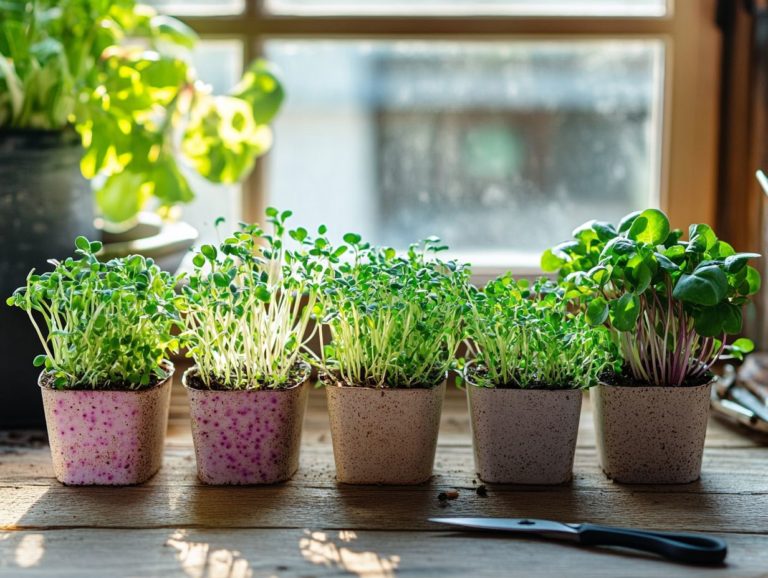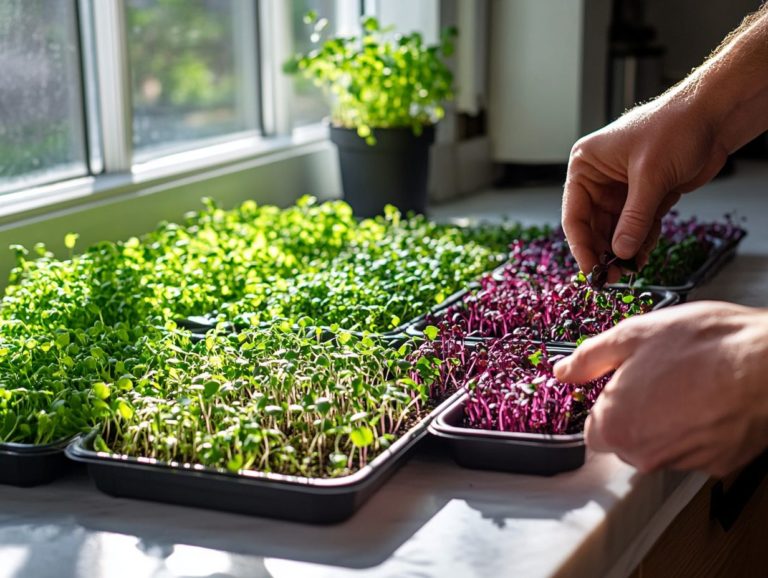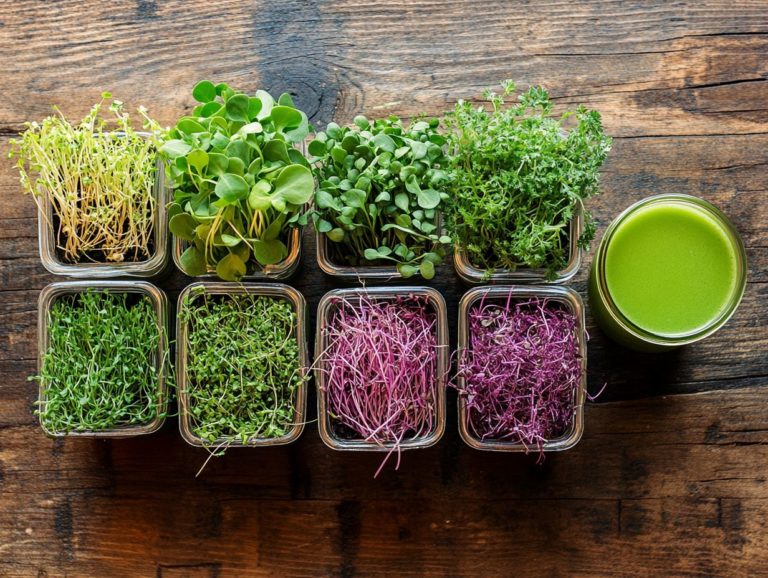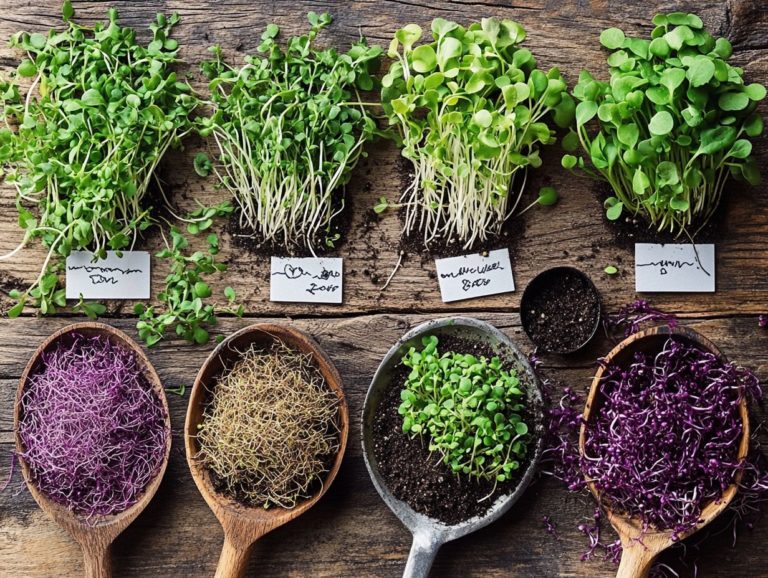5 Best Microgreen Varieties for Sandwiches
Microgreens are far more than a mere garnish; they are vibrant little powerhouses that can elevate your sandwiches to extraordinary heights.
Consider incorporating five of the finest microgreen varieties Broccoli, Radish, Sunflower, Pea, and Alfalfa along with red cabbage microgreens and carrot microgreens. These greens bring dynamic flavors and textures to your dishes and significantly enhance their nutritional profile.
Get ready to see how these tiny greens can revolutionize your meals! Explore their impressive health benefits and gather tips for cultivating your own at home.
Prepare to take your sandwich game to the next level!
Contents
- Key Takeaways:
- 1. Broccoli Microgreens
- 2. Radish Microgreens
- 3. Sunflower Microgreens
- 4. Pea Microgreens
- 5. Alfalfa Microgreens
- What Are Microgreens?
- Frequently Asked Questions
- What are the top 5 microgreen varieties to add to sandwiches?
- Why are pea shoots an ideal microgreen for sandwiches?
- What makes sunflower shoots a popular choice for sandwiches?
- How do radish greens enhance the flavor of a sandwich?
- What are the benefits of using broccoli microgreens in sandwiches?
- Why is micro arugula a top choice for sandwich garnishes?
Key Takeaways:
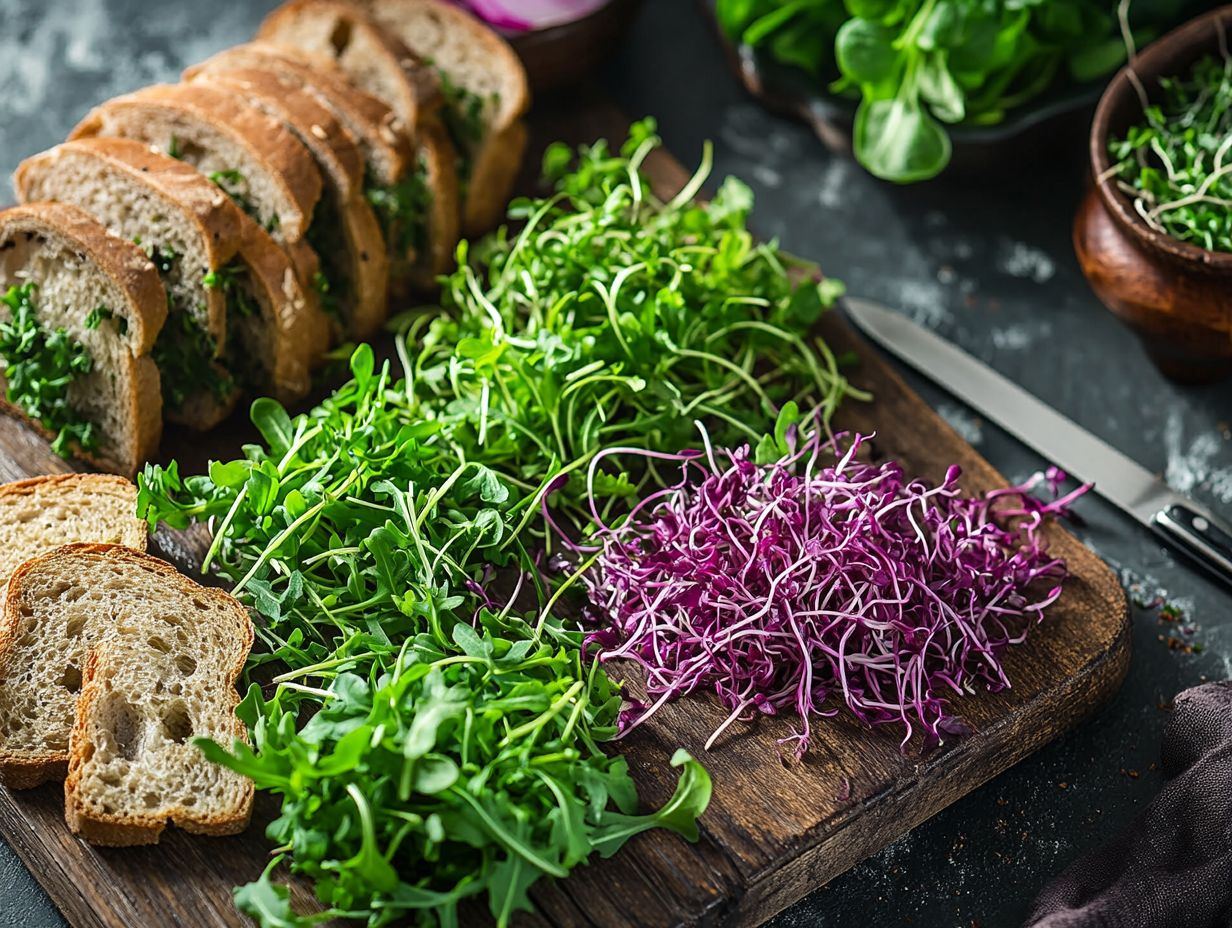
- Broccoli microgreens are packed with nutrients like vitamin C and a compound that may help fight cancer, making them a healthy and flavorful addition to sandwiches.
- Radish microgreens add a spicy kick to sandwiches and are rich in antioxidants, making them a great choice for a boost of flavor and nutritional value.
- Sunflower microgreens have a slightly nutty flavor and are a good source of protein, making them a satisfying and nutritious topping for sandwiches.
1. Broccoli Microgreens
Broccoli microgreens are brimming with essential vitamins and nutrients, making them a superb choice for anyone eager to infuse their diet with more greens. These petite, flavorful greens thrive in various settings. They are a delightful addition to salads, smoothies, and countless dishes, enhancing both nutrition and taste.
Their distinctively peppery and nutty flavor sets them apart from other microgreens like sunflower or pea shoots, which tend to lean towards the sweeter side. This unique flavor allows them to elevate a wide array of meals, whether you’re topping a hearty sandwich or stirring them into soups for an extra nutrient boost. For those interested in growing them, learning how to choose microgreen varieties for your garden can provide valuable insights. Broccoli microgreens are pivotal in crafting vibrant and nourishing green smoothies or fresh pesto, offering remarkable culinary versatility.
Growing these greens is simple, making them a favorite for urban gardeners looking for easy-to-grow options like mustard microgreens.
2. Radish Microgreens
Radish microgreens are a flavor-packed addition to your culinary repertoire, bringing a delightful peppery taste that can elevate salads, sandwiches, and even smoothies, all while offering a wealth of nutritional benefits.
As you delve into the growing requirements of these tiny greens, you’ll find that radish microgreens thrive in various indoor settings and adapt beautifully to your home gardening efforts. Their vibrant, crisp leaves are teeming with vitamins, minerals, and antioxidants, making them a powerhouse for health benefits, including potential support for heart health and improved digestion.
Their distinct flavor pairs seamlessly with a myriad of ingredients, enhancing everything from citrus-based dressings to creamy dips. Consider using radish microgreens as an exquisite salad topping or a zesty garnish on entr es, delivering both visual appeal and a delightful crunch that elevates your meals to new culinary heights.
3. Sunflower Microgreens
Sunflower microgreens are not only a breeze to grow but also deliver a delightful crunch and nutty flavor, making them a favored choice for both home gardeners and chefs looking to elevate their salads and other dishes.
With minimal effort on your part, these vibrant greens can thrive in just a couple of weeks, adding versatility to your culinary endeavors. Their crisp texture brings a satisfying crunch, while their flavor enhances everything from simple salads to gourmet entr es.
Packed with vitamins, minerals, and antioxidants, sunflower microgreens are a powerhouse addition to a healthy diet. You can effortlessly incorporate them into sandwiches, adding an exciting layer of taste and nutrition, or sprinkle them over soups for a vibrant garnish. Feeling adventurous? Blend them into smoothies for a nutritious boost. For more options, check out this quick guide to common microgreen varieties as they truly shine as a fantastic ingredient to experiment with in a variety of recipes.
4. Pea Microgreens

Pea microgreens have a sweet, fresh flavor. They are tasty and packed with nutrients, making them a great choice for enhancing meals.
These petite greens are harvested just after their first leaves appear. They are packed with vitamins A, C, and K, along with essential minerals like iron and magnesium.
Growing them is straightforward. You can cultivate them at home with just a bit of soil and sunlight.
Try adding pea microgreens to your salads for exciting crunch and vibrant color. They also enhance the flavor of sandwiches, providing a fresh burst of sweetness. For an extra nutritious twist, toss them into your smoothies; they blend effortlessly with fruits to create a wholesome drink that nourishes both body and palate.
5. Alfalfa Microgreens
Alfalfa microgreens are a treasure trove of vitamins and nutrients. They enhance the nutritional profile of meals while adding a delightful, crunchy texture to salads and sandwiches.
These vibrant greens flourish in well-draining soil and thrive under ample sunlight, ideally growing in temperatures between 60-70 F for optimal results.
Packed with health benefits, alfalfa microgreens boast impressive levels of vitamins A, C, and K, along with essential minerals like calcium and iron. They make a superb addition to your health-conscious diet.
To elevate your culinary creations, consider using these microgreens as:
- a topping for fresh salads,
- an ingredient in wraps for a delightful crunch,
- or a boost in your smoothies for added nutrition.
Their versatile flavor profile harmonizes beautifully with various dressings, enriching both texture and taste across an array of dishes.
What Are Microgreens?
Microgreens are young edible plants that you can harvest at an early stage. They are brimming with concentrated flavors and essential nutrients. They re perfect for enhancing sandwiches, salads, and many other culinary creations.
These tiny greens don’t just look good on your plate; they provide a burst of flavor that can elevate even the simplest sandwich to gourmet status. They are versatile and easy to grow. For those interested in exploring different types, check out microgreen varieties: a guide for beginners. Anyone can use them to add healthy ingredients to their meals.
Among the numerous options, varieties like arugula, radish, and basil truly shine with their distinctive flavors and impressive nutritional profiles. Choosing the right microgreen seeds like arugula microgreens delivers a peppery kick that pairs beautifully with hearty fillings. Radish microgreens introduce a crisp, zesty note that perfectly balances creamy spreads.
Nutritionally, these miniature powerhouses are packed with vitamins, minerals, and antioxidants that can significantly contribute to your overall health. If you’re interested in growing microgreens at home, a simple setup with shallow trays and a soilless growing medium a mix that helps plants grow without traditional soil can yield delightful results within just days.
Integrating these greens into your daily cooking is a breeze. Sprinkle them atop omelets, blend them into smoothies, or use them as a fresh garnish. They effortlessly enhance both the nutritional value and flavor of any meal, especially when using exotic microgreen varieties for a unique twist.
What Are the Nutritional Benefits of Microgreens?
Microgreens are renowned for their remarkable nutritional advantages. They often boast higher concentrations of vitamins and nutrients compared to their mature counterparts, making them a powerful addition to your diet.
These petite greens, ranging from radishes to beets, are vibrant in color and packed with essential vitamins and minerals. For example, broccoli microgreens are rich in sulforaphane, a compound celebrated for its antioxidant properties. Sunflower microgreens, on the other hand, are brimming with vitamin E, which benefits skin health. Incorporating the top 5 microgreens for smoothies can enhance both flavor and nutrition.
Incorporating these nutrient-dense greens into your daily meals can effortlessly bridge dietary gaps, enhancing your nutrient intake. Whether you sprinkle them on salads, blend them into smoothies, or use them as garnishes, growing your favorite microgreen varieties can significantly elevate the nutritional profile of even the simplest dishes.
How Can Microgreens Enhance the Flavor of Sandwiches?
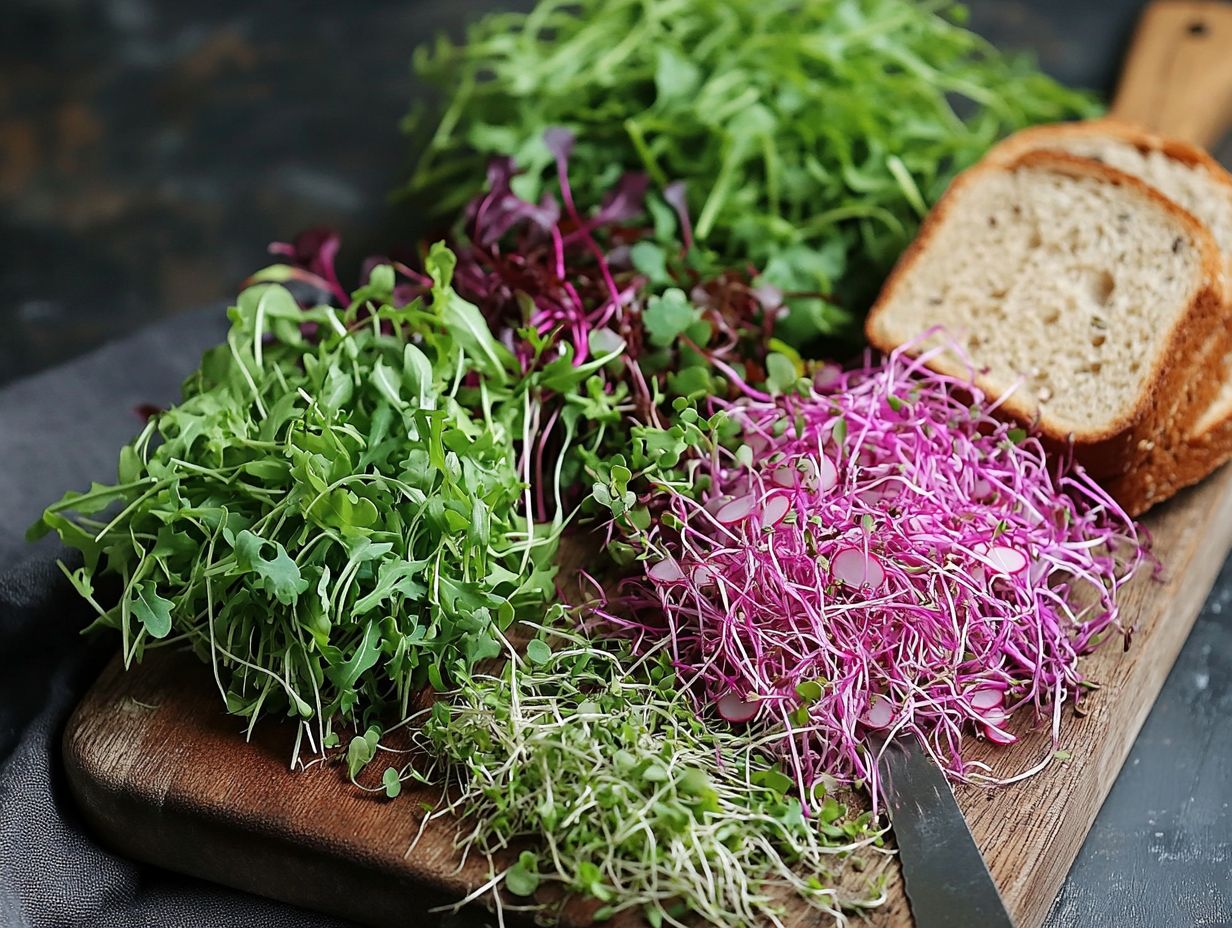
Microgreens have the remarkable ability to elevate the flavor of your sandwiches, presenting an array of taste profiles from the peppery zest of radish microgreens to the sweet notes of pea microgreens. They are a must-have for any food lover.
These petite greens not only introduce depth and complexity to your dishes but also bring vibrant colors and textures that enhance the overall presentation. For example, consider transforming a classic turkey and Swiss sandwich with the addition of tangy arugula microgreens. They deliver a zesty kick that perfectly balances the richness of the cheese. To explore more options, check out these must-try microgreen varieties for salads.
A simple cucumber and cream cheese sandwich can be beautifully complemented by the mild sweetness of sunflower microgreens, enriching the flavor without overshadowing the other ingredients.
Diving into these combinations opens up a universe of possibilities, perfect for both simple lunches and gourmet creations.
What Are the Different Ways to Incorporate Microgreens into Sandwiches?
Incorporating microgreens into your sandwiches offers a wealth of possibilities. You can use them as a fresh topping, a zesty garnish, or even blend them into spreads. They bring both nutritional value and enhanced flavor to the table.
Layer them between slices of your favorite bread or whip up a vibrant pesto, a sauce made from basil, garlic, and nuts blended with olive oil, that highlights these tiny greens your options are truly boundless!
If you re aiming to boost the texture, a generous sprinkle on top will add a delightful crunch. Blending them into creamy spreads will introduce unexpected flavor notes, surprising and delighting your palate.
This showcases the remarkable versatility of microgreens, proving they effortlessly elevate not just the taste but also the visual allure of any sandwich. Each bite becomes a unique experience, transforming an ordinary meal into something extraordinary.
How Can One Grow Their Own Microgreens for Sandwiches?
Growing your own microgreens for sandwiches is an incredibly rewarding experience that s surprisingly easy. You can enjoy fresh, home-grown greens right from your kitchen or garden.
These vibrant little plants bring a burst of flavor and nutrition to your meals—what a delightful bonus! To embark on this journey, start by selecting seed varieties like radish, basil, and pea shoots. For more information on maximizing their benefits, check out the best microgreens for nutritional value. These options are known for their quick growth and exceptional taste.
Create the ideal environment by ensuring sufficient sunlight or utilizing grow lights. Keep a close eye on moisture levels to avoid overwatering. With a bit of care and attention, you’ll soon discover that these tiny greens thrive, infusing joy and health benefits straight onto your plate.
What Are Some Other Uses for Microgreens Besides Sandwiches?
Microgreens are not just fantastic for sandwiches; their versatility knows no bounds! They serve as vibrant toppings for salads, ingredients for smoothies, and decorative elements in a myriad of dishes.
These tiny powerhouses bring a delightful range of flavors and textures that can elevate any meal. When you add them to salads, you re not just introducing a pop of color; you re enhancing the nutritional profile as well, with vitamins and minerals often more concentrated than those found in mature vegetables.
In smoothies, microgreens blend effortlessly, providing a nutrient-rich boost without overshadowing the existing flavors. Their potential as garnishes is truly unparalleled a sprinkle of these greens can transform a simple dish into a gourmet experience, making them a beloved choice for both chefs and home cooks alike.
Frequently Asked Questions
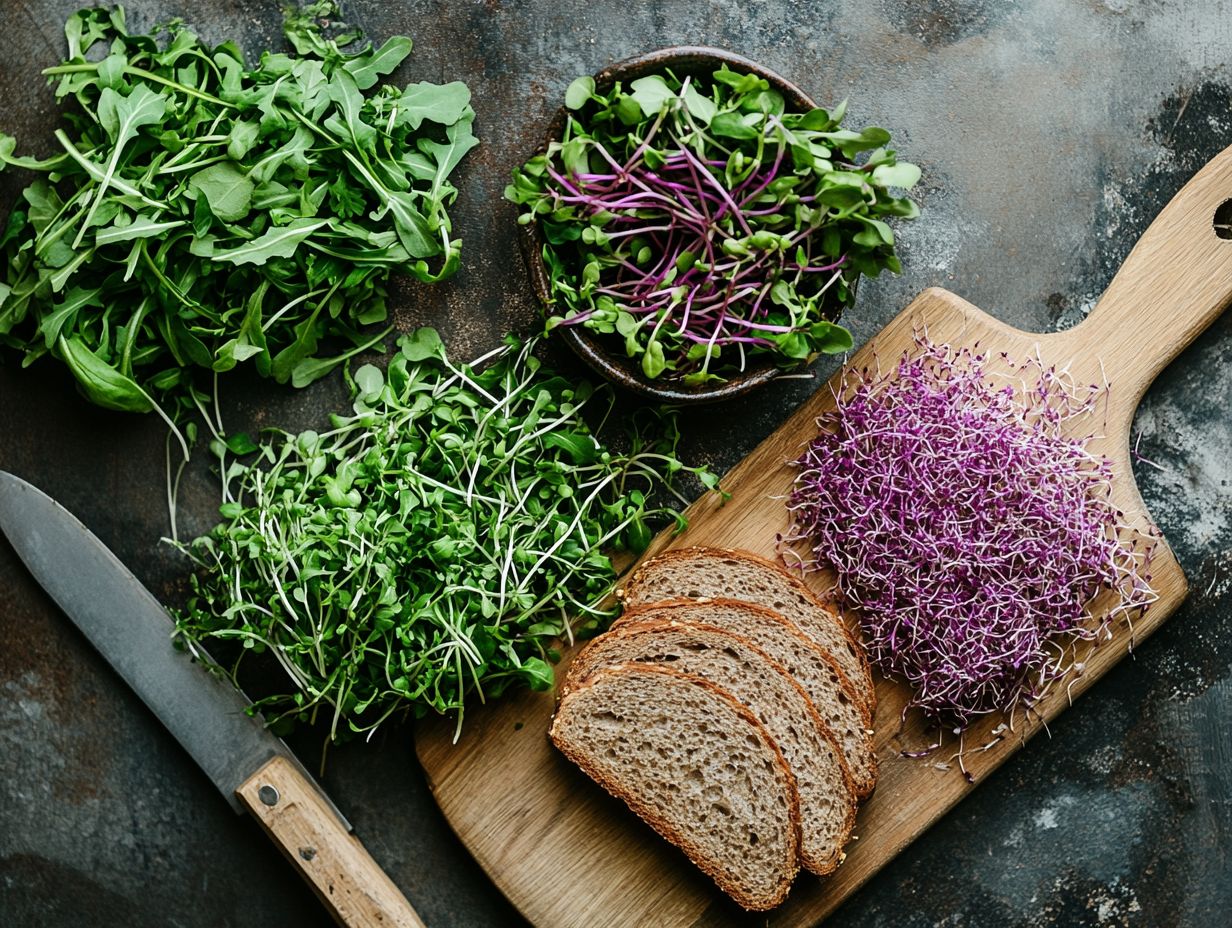
What are the top 5 microgreen varieties to add to sandwiches?
- Pea shoots
- Sunflower shoots
- Radish greens
- Broccoli microgreens
- Micro arugula
Why are pea shoots an ideal microgreen for sandwiches?
Pea shoots have a mild and sweet flavor, making them a versatile addition to any sandwich. They also have a crunchy texture that adds a satisfying element to your meal.
What makes sunflower shoots a popular choice for sandwiches?
Sunflower shoots have a nutty and earthy flavor. They pair well with various sandwich fillings and are packed with nutrients like protein, healthy fats, and vitamins.
How do radish greens enhance the flavor of a sandwich?
Radish greens offer a peppery and slightly bitter taste. This kick of flavor makes any sandwich exciting, and they’re rich in antioxidants and vitamins.
What are the benefits of using broccoli microgreens in sandwiches?
Broccoli microgreens have a mild, slightly sweet taste that complements other sandwich ingredients. They also provide fiber and vitamins C and K, adding nutritional value.
Why is micro arugula a top choice for sandwich garnishes?
Micro arugula delivers a bold, peppery flavor. It s a fantastic source of vitamins A, C, and K, making it a healthy addition to your meal.

